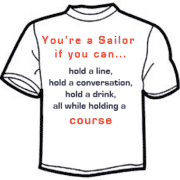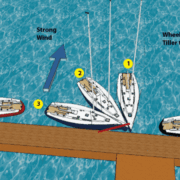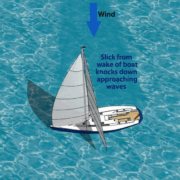Preventing the Frustrating Auto-Tack
If you like this freebie tip, LIKE us over there —-> thx for that!
First – what is an auto-tack?
It’s when you are sailing along on a close haul about 30 or so degrees off the wind minding your own business when either the wind changes OR you weren’t watching the boat turning up into the wind. Either way the wind now is coming from the front of the boat – it back-winds the jib sail and over you go onto the other tack. Oh man that is frustrating because there is now a lot of work to do with grinding in sheets, getting back up to speed then tacking back. Whew!
In addition, it makes you look like an absolute twit of a sailor – in front of new people and especially in front of experienced people. It’s a rookie landlubber thing to do.
Here is a couple of tips on how to prevent that. (thank goodness)
(1) As soon as it has happened take the wheel and do a giant turn to try to bring the boat back onto its original course. I’m not talking about just turning the wheel – it has to be a giant turn and it has to be fast. If you have a tiller then bring the tiller all the way over.
The reason you have to do this large and fast is that you still have velocity in the boat and the rudder at this point is still pretty effective but it has to overcome the very large force on the front of the boat because of the wind back-winding on the jib now pushing your boat around. You have a few seconds to use the rudder to quickly overcome the force and get it back around. The further the boat goes through the wind the greater the force at the front of the boat. Acting fast prevents the turning force on the jib from getting too big. The other thing that is happening is that the boat is very quickly losing velocity and this is making the rudder less and less effective. Force on the rudder is proportional to the square of the velocity. So if you halve the velocity the rudder become 4 times less effective.
So do a large and fast turn on the wheel or tiller to get the boat back to its original heading.
(2) Another thing to do is to instantly release the jib sheet. This totally takes away the front turning force on the jib, giving all control forces back to the rudder only. Provided you have any speed left in the boat, usually you can get it back around.
Number 1 above is best because it involves less grinding – if you can get it back. Number 2 should be instantly done if number 1 is not working. All in all both have to be done fast.
—
In reality, this should never really happen to you if you are constantly aware of the wind forces on the boat. You can feel these forces easily because the boat heels over (even slightly) due to the wind. If the boat begins to stand up straight it is happening for 1 of 2 reasons. 1- you are heading too close into the wind either by not paying attention to your heading or a wind shift to forward or 2 the wind suddenly dropped. In both cases you will make a turn downwind. 1 is obvious but 2 is because if the true wind drops then the apparent wind shifts to more come from the front of the boat. Thus in both cases, when the boat stands up you should be turning the boat downwind. Number 2 (wind drop) is not going to make you auto-tack but number 1 a wind shift to forward or an unbeknownst unwatching turn into the wind will make you auto-tack.
Thus the zeroth way to prevent an auto-tack is to feel the boat. But this takes more experience.
Anecdote: One time I was out with some friends sailing. I had a friend steering. He kept on doing autotacks – from just not paying enough attention and not feeling the boat stand up and not making the turn down wind. I told him the next time he did that he would have to start doing all the work on the jib sheets. That fixed him – he doesn’t do it anymore. Hee hee. Learn by fire!
Here is a quick animation to show a rookie helmsperson not paying attention and turning the boat up into the wind. Half way through you release the jib sheet removing the forward force and then also doing a big turn downwind with the rudder.
Here is another great similar article on a concept called pinching and what it is doing to the boat and how to feel it and how not to do it.
Enjoy!
Some sailing courses/books try to give you the stiff technical stuff on sailing. NauticEd courses get right down into the nitty details like this to make you a better sailor all around.
Take the NauticEd Skipper Course and learn the technical details but also so many tips and tricks you’ll come out looking and sounding like a professional. For Beginner to intermediate sailors, the NauticEd Skipper Course should be your first stop.
Learn more about the interactive eLearning NauticEd Skipper Course Now!







